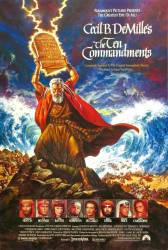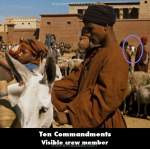Continuity mistake: When the movie ends, Moses places both hands on Joshua's head. From the opposite angle they're away. (03:43:50)
Continuity mistake: When the movie ends, Sephora rests against Moses' shoulder and places her left arm on his body. From the angle shot from behind, she is away from him and her left arm is signaling the horizon. Back to the front shot, and she is in the previous position.
Continuity mistake: At the end when Moses reaches out to the tablets, in the first shot he has nothing in his hand, second shot he has something black which at first looks like sunglasses, and in the third shot his hand is empty again.
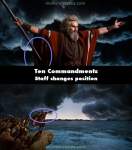
Continuity mistake: Before Moses parts the sea waters, he cries, "Behold his mighty hand!" and extends both arms, his staff covered by his cloak. From the angle shot from behind, the staff is now over the cloak.
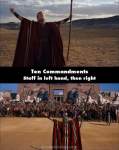
Continuity mistake: When Moses leads the Hebrews from Egypt, he pauses before them to deliver a little speech before they head out into the desert. He faces the camera and lifts his staff up with his left hand. But on the cutaway shot from behind, he is holding the staff in his right hand.

Continuity mistake: When Moses returns from Ethiopia amidst great fanfare, he's wearing two golden wings crisscrossed across his chest. At first they are crisscrossed with his left wing over his right, but when Moses kneels in front of Sethi, the wings are crisscrossed the opposite way, with his right wing over the left. These golden wings continue to switch positions repeatedly in the following shots. (00:21:20)

Continuity mistake: When Moses confronts his Egyptian mother Bithiah with the Hebrew piece of cloth, she is beading on an Egyptian loom. During this scene, the string that she is beading (the farthest to our right) first matches the height of the other strings. One shot later, there is suddenly more beads, making the string higher than the others. (00:57:40)
Continuity mistake: When Bithiah brings the cradle ashore the way the towel on the left is folded changes between shots.
Continuity mistake: When Moses is left alone in the cradle Miriam's left-hand keeps changing positions between shots.
Continuity mistake: The distance between Rameses and Moses alternates from elbow to elbow to about three feet apart as the shots change when the duo are facing Seti during the Ethiopian tribute scene.
Continuity mistake: When Nefertiri and Moses are saying their goodbyes in the cave, his shackled right hand starts to stroke the upper left side of Nefertiri's hair, but the next cut shows Moses' hand lower down.
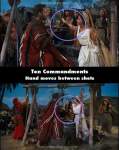
Continuity mistake: When Sephorah first talks to Moses, she is touching the rope holding the bucket over the well. She's not touching it anymore in the next shot.

Continuity mistake: When Moses is exposed as a Hebrew, Sethi is holding his scepter up in his left arm, and Nefretiri tosses her feather to the ground. In the next shot, Sethi's scepter has vanished.
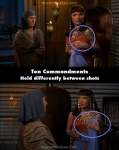
Continuity mistake: When Nefretiri is told by Memnet that there will be a Hebrew on the Egyptian throne, she lowers the cloth that she is holding. In the next shot, she is holding it up higher again.
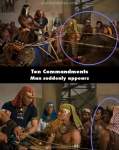
Continuity mistake: When Moses asks Rameses where extra grain can be found to feed the slaves, look at Joshua. In the next shot, a guard suddenly appears in front of him.
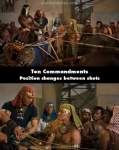
Continuity mistake: When Rameses is asked by Moses if there is any extra grain to feed the slaves, Rameses' pose changes between shots.

Continuity mistake: When Moses and Joshua are reunited and Moses denies God's purpose for him (he says "I am not the man"), Moses has his arm around Joshua's back. In the next shot, Moses is only touching Joshua on the shoulder.

Continuity mistake: When Seti orders that The Deliverer be summoned, he hands the bottle that Rameses gave him earlier without looking at him. In the next shot, he is looking at Rameses.
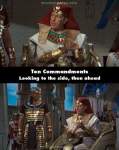
Continuity mistake: When Seti is told by Rameses that he has caught The Deliverer, Seti is looking at Rameses. In the next shot, Seti is looking straight ahead.
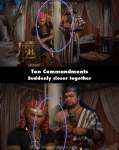
Continuity mistake: After Rameses slaps the coin out of Dathan's hand, the shot cuts to Dathan being much closer to Rameses. Another instant cut and Dathan is further from Rameses again.
